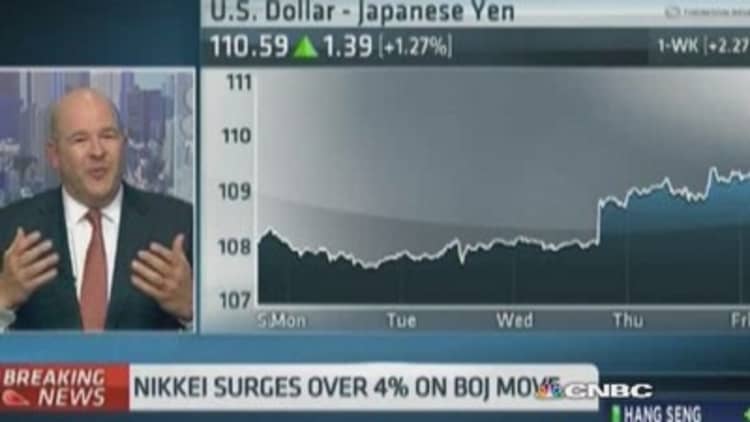Bank of Japan Governor Haruhiko Kuroda, who last week stunned global financial markets by expanding a massive monetary stimulus program, said the central bank is ready to do more to hit its 2 percent price goal and recharge a tottering economy.
Kuroda stressed the BOJ is determined to do whatever it takes to hit the inflation target in two years and vanquish nearly two decades of grinding deflation.
"There's no change to our policy of trying to achieve 2 percent inflation at the earliest date possible, with a roughly two-year time horizon in mind," the central bank chief said in a speech at a seminar on Wednesday.
"There are no limits to our policy tools, including purchases of Japanese government bonds," he said in response to a question from a private analyst after the speech.
Read MoreBOJ surprises with fresh stimulus, Nikkei surges 5%
The BOJ shocked global financial markets last week by expanding its massive stimulus spending in a stark admission that economic growth and inflation have not picked up as much as expected after a sales tax hike in April.
Kuroda said while inflation expectations have been rising as a trend, the BOJ decided to ease to pre-empt risks that slumping oil prices will slow consumer inflation and delay progress in shaking off the public's deflationary mind-set.
"In order to completely overcome the chronic disease of deflation, you need to take all your medicine. Half-baked medical treatment will only worsen the symptoms," he said.
Kuroda repeated the BOJ's projection that Japan will likely hit the bank's price target sometime in the next fiscal year beginning in April 2015, supported by the expanded quantitative and qualitative easing (QQE) program.
Read MoreBank of Japan battles entrenched 'deflation mindset'

While he stressed that Japan's economy continued to recover moderately, Kuroda said falling commodity prices could be risks to the outlook if they reflected weakness in global growth.
In deploying QQE last April, the BOJ pledged to double base money via aggressive asset purchases to achieve its 2 percent inflation target in roughly two years. But many analysts still doubt whether inflation will accelerate so quickly in a country that had been mired in deflation for nearly two decades.
The Japanese economy was hit hard in the second quarter, suffering its biggest slump since the global financial crisis after an April sales tax hike dented consumption, and is expected to rebound only moderately in the third quarter as the effects of the higher tax take time to wear off.
Kuroda stuck to his view that the pain from the tax hike will gradually subside, but warned that the BOJ must be mindful of how the higher levy could affect companies' pricing power, particularly if household spending stagnates.
Read MoreAbe balances tax rise against economic damage
On the yen's plunge against the dollar after last week's monetary expansion, Kuroda reiterated his view that overall, a weak yen was positive for Japan's economy.
While some households and service-sector firms could feel the pinch from higher import costs, a weak yen tends to push up export volumes and boosts profits of Japanese companies with overseas operations, the central bank chief said.
"The benefits of a weak yen outweigh the costs if the yen's declines reflect economic fundamentals," he said.
A weak yen had traditionally benefited Japan's economy by boosting exports. However, the positive effects of a softer currency have been partially nullified as more companies have moved their production overseas in recent years.
Read MoreJapan's yen is about to get pummeled—even more
Moreover, an increasing number of lawmakers and companies have recently complained that further yen declines could do more harm than good by boosting import costs.
The BOJ's surprise easing last week sent the stock average surging to a seven-year high and the slumping to a seven-year low versus the dollar.

